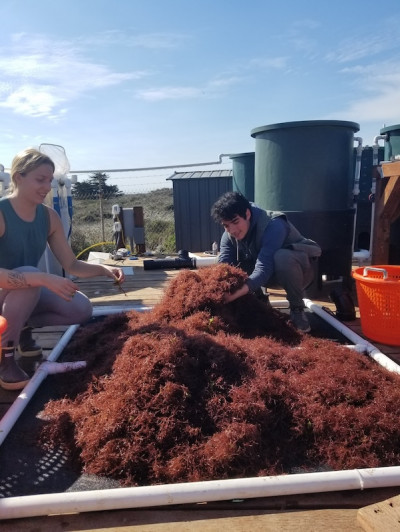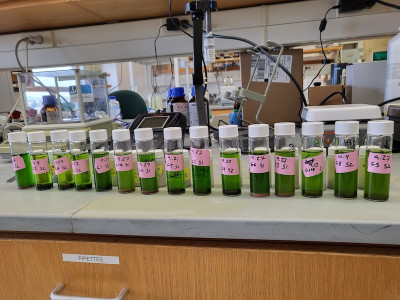This is the seventh in a yearlong series of stories showcasing the research that the Ocean Protection Council supported in partnership with California Sea Grant, with funding from Proposition 84.
It’s an idea that’s sparked enthusiastic headlines across the world: Feed cattle seaweed and you can help address the ongoing climate crisis.
Cows, like all ruminants, belch methane, a potent greenhouse gas. Indeed, California's cattle produce more than half of the state’s methane emissions; across the globe, the beef industry accounts for 9% of greenhouse emissions of all kinds. The good news is that certain seaweeds, when added in small amounts to feed, reduce the production of the enzyme that produces the methane without altering the taste of the beef (or milk) or the cow’s ability to gain weight.

That, to Luke Gardner, was exciting news: He’s a California Sea Grant Extension Specialist based at the Moss Landing Marine Laboratories, San Jose State University, and his job, as he puts it “is to find new ways to think about growing seaweed, and what to do with seaweed in the state.”
There was one problem, though. Gardner knew Asparagopsis taxiformis, the species that has proven so useful in previous studies, is difficult to farm. And even if the secrets of production were unlocked, Asparagopsis is a warm-water species that grows best in equatorial regions. Although it can be found in Southern California, it is considered an exotic species, making farming in open water an unlikely prospect. So, using Ocean Protection Council funds that were authorized through Prop 84, Gardner formed a research team with Moss Landing Marines Labs and the U.S. Department of Agriculture’s Agricultural Research Service. Their goal: investigate whether some local species of seaweed might produce the same effects.
It’s a particularly important quest for Gardner, who, when he’s away from the seaweed, spends most of his time around cows. Gardner married into a small cattle ranching operation in central California, which has helped him understand that something has to be done about methane: A California law has mandated a 40% reduction in methane emissions by 2030.
“It’s not a trivial problem,” he says. While methane does not persist in the atmosphere nearly as long as carbon dioxide, for the period it stays up there, this gas has a far more potent warming impact. And California has more dairy cows than any other state.
Gardner and his team selected 28 seaweed species from across the three major groups of algae (red, brown and green seaweeds), some of which are already farmed in California, some of which could potentially be grown here. Since field studies — in which the seaweed is directly fed to cattle — are slow and expensive, the team first conducted “in vitro” digestion studies at USDA’s Oklahoma and Central Plains Agricultural Research Center, in collaboration with the center’s director, Stacey Gunter. In a test tube, the USDA scientists mixed stomach fluids, pulled directly from a cow, with the kinds of grasses cows are likely to forage, plus a small amount of seaweed, which made up about 2% of the contents of the feed in the experimental recipe. Then the scientists heated the mixture to the same temperatures as an actual cow stomach and tracked what gases were produced. As a control, Gardner and his team included Asparagopsis taxiformis as one of the species examined in these studies.
Consistent with previous studies, the project team found Asparagopsis reduced methane production on the order of 80%. They also found that two species of the genus Gracilaria had some promise — though they only produced reductions of between 10 and 20 percent.

“It’s a distant second,” Gardner concedes, “but the benefit of Gracilaria is that it is grown on an industrial scale.” One Gracilaria species, for example, red ogo, is eaten by humans and also rendered into agar, a substance used as a thickener in both medical and culinary applications. “So even if [Gracilaria] is not so potent, maybe we can grow it more easily,” Gardner says, thereby helping ease the process of adding seaweed to cattle feed.
Scientists have theorized that what makes Asparagopsis so effective are high amounts of bromoform, an organic compound found in most seaweeds and phytoplankton, that is thought to provide defense against damage from microbes and sunlight. So Gardner and his team grew Gracilaria in varied conditions to see if they could increase its bromoform content. They found that the amount of bromoform in seaweed is highly dependent on light exposure: At peak sunlight, the bromoform in the seaweed is as much as two to three times higher than in the morning. He also found that if the seaweed was exposed to the air for short periods, a process known as desiccation, that too increased bromoform concentrations.
While these trials only focused on Gracilaria species, “we think that is probably going to be the same for a lot of different seaweed species,” Gardner says. That means if farmers want to produce better seaweed for cattle feed, they might, in general, want to maximize light exposure and harvest it at peak sunlight and outplant in places where, at low tide, the seaweed will be exposed.

The next step was to feed the seaweed to actual cows. But, unfortunately, Gardner and his team found they’d produced less Gracilera than hoped. Moss Landing Marine Laboratories, in Monterey, isn’t as warm or sunny as would be ideal for Gracilaria production. Given a lack of space, rather than growing the seaweed on lines, as is typical elsewhere, Gardner and his colleagues employed a technique known as “tumble culture,” in which the seaweed grows in tanks. Other seaweeds wound up growing on the Gracilaria, reducing overall production. In total, Gardner produced around four thousand pounds of seaweed. Once he freeze-dried it, the weight dropped by more than 95%, far more than he’d expected based on the prior literature. So he had only a few hundred pounds of dried product to ship to Ken Kalscheur, a scientist at the USDA Dairy Forage Research Center in Madison, Wisconsin, who oversaw the field trials.

“The problem is that dairy cows eat a lot,” Gardner says — ten thousand pounds of dry matter in a year. So the smaller-than-anticipated amount of seaweed only allowed a small study, with 12 cows eating seaweed, and 12 cows as controls. And the cows could be given only very low doses of seaweed: the “inclusion rate,” or amount of feed that was seaweed, was just 0.75%, well below the rate Gardner had used in his laboratory study. So Gardner was not surprised when the reduction in methane production in the cows was less than what he’d found in his laboratory trials. Gardner considers the study inconclusive: Feed the cows more Gracilaria and the results might be better.
The tentative results, Gardner notes, still underline the importance of the work that he is already doing: California needs more infrastructure for growing seaweed. He thinks there are hopes for Gracilara, even if it will never perform so well as Asparagopsis. Some studies have shown that cows start to eat less if more than 2% of Asparagopsis is included in their feed, perhaps due to taste — a nonstarter for an industry that depends on cows soaking up sufficient calories. But those tests have not been conducted Gracilaria, which could be more palatable So he’s still plugging away on behalf of California’s cows and seaweeds both.